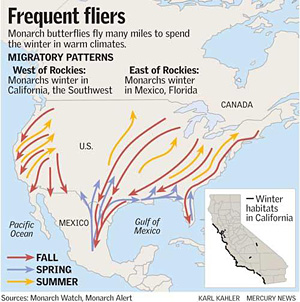
|
 |
 |
 Editorials | Environmental | March 2008 Editorials | Environmental | March 2008  
The Monarch Butterfly's Mysterious Migration
 Agence France-Presse Agence France-Presse
go to original
First Posted 18:34:00 03/22/2008


| | When spring arrives, the butterflies' subsequent generations make their way towards Canada and eventually return to Mexico the following autumn. | | |
Ocampo, Mexico - Each autumn, millions of Monarch butterflies embark on a treacherous journey across North America to the same forest in central Mexico - a migration that baffles scientists as much as it enthralls nature lovers.

Taking wing in an unrelenting stream from Canada, the orange and black "flying flowers" return like clockwork to an ancestral homeland they have never seen 4,500 kilometers (2,800 miles) away, where they will lay their eggs to carry on the species.

Mexico's National Commission for Natural Protected Areas (CONANP) has published scores of studies on the migrating and wintering habits of the species scientifically known as Danaus plexippus, but exactly why they take their flight of instinct to the volcanic hills of the state of Michoacan is shrouded in mystery.

Flying about 80 kilometers (50 miles) per day, the Monarchs reach Mexico at the end of a two-month voyage which includes more than 40 stopovers.

"Sometimes it's possible to see swarms of butterflies arriving in these Mexican forests," says Ricardo Adaya, a technician at the Monarch Butterfly Reserve in Rosario, Mexico's largest such sanctuary.

Not all Monarchs reach Mexico. Only one of every five generations is able to migrate from the Rocky Mountains in the Western United States and Canada to reach the warmer temperatures south of the United States.

This generation lives longest, up to six or seven months, a process heavily influenced by climate.

Adaya says the butterflies leave a greasy film on the trees and ground which could serve as a sort of homing beacon for future generations arriving in the Mexican hills.

The males often die shortly after mating, and the females after hatching their eggs. When spring arrives, the butterflies' subsequent generations make their way towards Canada and eventually return to Mexico the following autumn.

The butterflies gather in such massive numbers that they sometimes cover whole trees and weigh down their branches. They take to the air in dark cloud-like formations or flit between the trees some 3,000 meters (9,900 feet) above sea level.

Some locals turn to the reverence of ancestral rites to explain the potent imagery.

"A native legend says that the butterflies are actually the souls of the dead who return to visit the living," said Carmen Martinez, who oversees the 300-hectare (740-acre) Chincua sanctuary.

The butterflies' arrival in Mexico in November coincides with All Saints Day, which seems to magnify the aura surrounding them.

The Monarch sanctuary in the temperate volcanic mountain range is under serious threat, however. Illegal logging could deprive the species of the ecosystem they have grown dependent on.

But the region's inhabitants, whose livelihoods depend in large part on butterfly-driven tourism, are fighting back. Many have arranged forest surveillance teams and alert police to the presence of black-market loggers.

"They are armed," Martinez said of the traffickers, "so we run the risk if we try to chase them down ourselves."

To help raise environmental awareness about the site, and ultimately gain prestigious world heritage status from United Nations cultural organization UNESCO, CONANP is launching an exhibit beginning April 30 in Paris that will allow visitors to cover themselves with Monarch butterflies. | 
 | |
 |



